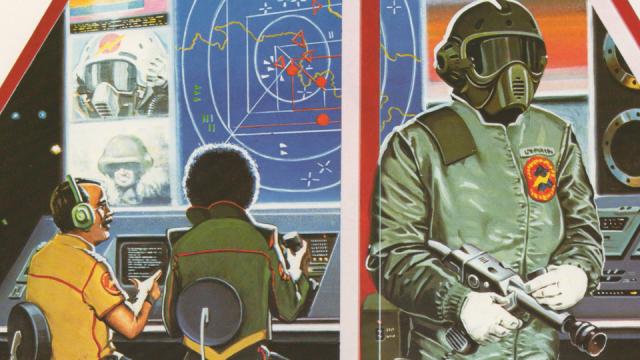Here in the 21st century, soldiers can be sitting in a room in New Mexico while piloting an unmanned aerial vehicle halfway around the world in Afghanistan. Back in the early 1980s this kind of reach was still largely the stuff of science fiction. But the incredibly rapid development of computing power and satellite communications during this period assured futurists that it would become fact before long.
In the 1980s, kids who scoured the library for anything and everything futuristic (as I did) might have come across this vision of war in the future. According to the 1981 book, Future War and Weapons, by Neil Ardley the future of war was computerized, it was remote, and it had plenty of lasers — albeit for communication, rather than space warfare.
Just as the computer is invading our peace-time lives today, it will be at the heart of fighting forces in the future. Computer control will greatly improve the performance of military machines. Modern fighter aircraft, for example, would spin out of control without onboard computers to help pilots to fly them. But the most important use of the computer in war will be in the command post.
Silicon Valley did its part to help make this dream a reality. Today popular history remembers the region for its role in developing personal computers, but it was those onboard computers for fighter planes that Ardley mentions which helped establish the region as a computerized force to be reckoned with.
As Thomas Heinrich explains in his 2002 paper titled “Cold War Armory: Military Contracting in Silicon Valley,” during President Reagan’s 1980s defence build-up the region was taking in about $US5 billion annually from defence contracts :
[During the Cold War] Santa Clara County (which was first dubbed Silicon Valley in 1971) produced all of the United States Navy’s intercontinental ballistic missiles, the bulk of its reconnaissance satellites and tracking systems, and a wide range of microelectronics that became integral components of high-tech weapons and weapons systems. Aircraft like the F-16 tactical fighter could not fly, much less engage in combat, without transistors, integrated circuits, and microprocessors that collected and processed flight data, linked the plane to external command, control and communication systems, and guided “smart” bombs and missiles to their targets.
Ardley explains that those commanding the armies of tomorrow won’t need to be physically close to the fighting. Advancements in communications technology will assure the good guys that they have the upper hand.
Here you can see military commanders at work in a future conflict. Their base is situated far from the fighting in a secret location. The command room is built deep underground to escape destruction in an enemy attack. Nevertheless, because it is vital to victory, the base is still heavily guarded and strongly protected.
The commanders sit before a huge computer. Information about the battle is being constantly fed into the computer. Aircraft and satellites in space overhead send back pictures of the war zone, and soldiers and observers report on their own and enemy positions and progress. In addition, radar or laser signals track the movements of the forces. Radio or laser beams link the battlefield via satellites to the command computer.
Laser beams can carry immense amounts of information; the entire contents of the largest encyclopedia, for example, can be transmitted in only a second. The computer takes in all the information from the battle and displays a map of the conflict as well as any pictures the commanders choose. They see immediately what is happening in the battle as they issue commands. Terminals linked to the computer give vital information to the forces, showing them the exact positions and strengths of enemy units.
Because the computer knows the positions of all the forces in the battle, it checks all commands to make sure that enemy units are fired upon and that the commanders’ own forces are not placed in danger. Furthermore, the computer can suggest courses of action that will make the best use of the forces and advise against unwise decisions.
Overseeing military operations from afar is nothing new. But with each passing year, remote warfare becomes increasingly sophisticated. In many ways, it feels like this age of robotic warfare — ostensibly fought with fewer American boots on the ground — snuck up on us. But we don’t need to look much further than the pages of 1980s kids books (or movies) to see that the computerized war of tomorrow has been promised for generations.
